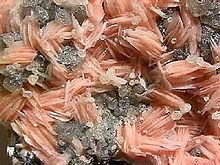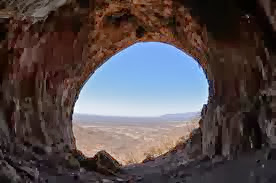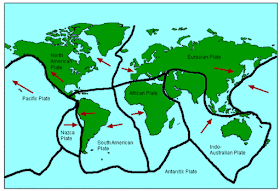Barite (spelled baryte everywhere besides the U.S) is a heavy, non-magnetic mineral with very high specific gravity of up to 4.5. It is one dense, soft rock. Barite (BaSO4) is useful in the manufacture of paper and rubber, as a tracking agent in medical tests in the human body, and as the weighting material put into drilling fluid to keep the sides of petroleum drilling casings from collapsing and to prevent blowouts. It is readily used down boreholes as it does not interfere with any magnetic tests associated with drilling. The pinkish crystals pictured below are barite. The darker, smaller mineral is cerussite. The radiating form of barite crystals is sometimes referred to as Bologna Stone (for the town in Italy, not the lunch meat):
Pure barite needs little jigging (essentially shaking the rock in an aqueous solution), washing, heavy media separation, tabling, or flotation to be used down well bores. The barite is merely crushed to a uniform size and put in the drilling mud. 77 percent of barite is used for this purpose. And even though it is a heavy mineral, it is considered non-toxic due to its high insolubility. Deep oceanic BaSO4 deposits are useful in constraining the temperatures of oceanic crust in paleoenvironments.
Barite in the form of desert roses is also coveted by rock hounds:
My remarkable six-month, first adventure out of college included mapping a barite deposit in Cobachi, Sonora, Mexico. I lived with two British geologists, Rod and Kevin, and a geologist from North Carolina, Phyllis, in the little white house in the left of the photograph:
The house had no windows, doors, or running water...but it was just $100 a month to rent. :-) Cobachi is so small (about 300-350 people) that it often does not show up on maps, even in our GPS age (though it does here):
Mapping the barite deposit including making a grid through the desert (with the help of a local crew of ten men with machetes), scaring cows off the runway so the small plane could land, performing specific density tests, stratigraphy and paleontology including late Paleozoic fusulinids, and learning Spanish. We also hiked to the top of Sierra Cobachi with our friends from the community. They carried thick, heavy Coke bottles up and down the mountain to this stunning cave:
This image of the people in Cobachi reminds me of how warm and kind they were to us very foreign-looking and sounding geologists. We would be treated to tomatoes on our burritos when they could afford none for their own families. They taught us to make tortillas and goat cheese and withstood us asking the same questions countless times as we learned Spanish. We took part in dances, loud wailing funerals, and evening talks about our day's adventures.
Anaconda Barite just announced they will be upgrading the jigging plant in Cobachi early this year. So the heavy mineral barite (named from the Greek word heavy) will provide more years of economic opportunities to Cobachians. Here's hoping the heavy Coke-bottle carrying is no longer going on, though :-).
Cobachi surely holds a heavy place in my heart...in a good way.
Any early career adventures you'd like to share? Or your own favorite barite story?
Sedimentally yours,
Word Woman (Scientific Steph)
























